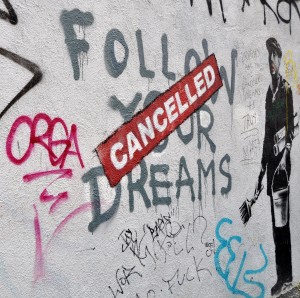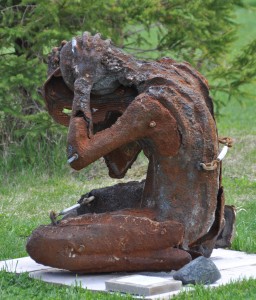
There is only one essential to keep in mind while under the blather barrage on Social Security, Medicare, Medicaid and Affordable Care: They’re a prize.
They’re a prize not of the kind of ballpark bobbleheads but rather of the greatest of the Civil Rights anthems, ‘Keep your Eyes on the Prize’. It’s the prize of which the Scot, John Davidson, wrote in ‘A Northern Suburb’ (1897), a poem about families soon to be evicted in the first wave of slum clearances:
For here dwell those who must fulfil
Dull tasks in uncongenial spheres,
Who toil through dread of coming ill,
And not with hope of happier years –
The lowly folk who scarcely dare
Conceive themselves perhaps misplaced,
Whose prize for unremitting care
Is only not to be disgraced.[1]
That prize – ‘not to be disgraced’ – is at stake this summer.
***
Davidson’s verses brought to mind Robert Moses. In his great biography of this master of social change, The Power Broker: Robert Moses & The Fall of New York (1974), Robert Caro describes the misery Moses’s slum clearances and highway projects caused ordinary people. In my scales of justice, the joys of Moses’s Jones Beach will never balance the horrors of his Cross-Bronx Expressway.
Preceding Moses’s massive – they were always huge – New York City projects were the evictions, as Davidson wrote, of thousands ‘roused by the fee’d policeman’s knock’. [2]
Always promised substitute housing, almost none got it. The infrastructure of neighborhood, houses of worship, jobs, sports – in short, community – disappeared in the improvements. And, their people were ‘misplaced’ and ‘disgraced’ in Davidson’s great phrasing.
***
Mr. Caro’s descriptions of the dislocations and destruction Moses inflicted after WWII on New York holds the key to understanding the 60s. [3] Irish, Italians and Jews could flee their neighborhoods, split and darkened by elevated highways. Blacks and Puerto Ricans couldn’t. They were forced, compressed into ghettos, as Harlem and the South Bronx became.
Hence, the New York ‘race riots’ of the mid- to late-60s. But my hunch is that they were more about ‘misplacement’ than race. And, that misplacement occurred nationwide with less visible, yet more profound consequences for the country’s spirit and psyche.
***
Beginning in the 1910s, Moses had built a persona as a man above politics, as a planner who considered only the greater good. Moses’s notions of social planning dominated the country in every area significant to America’s twentieth century.
That’s not an exaggeration. Just as Moses ruled on electric utilities, public housing, transportation, parks, bridges and highways in greater New York, his acolytes dictated across the US. Boston’s urban wastes, most notably the old West End and today’s Government Center, were Moses-type renewal areas in the 50s and early 60s.
The much ridiculed ‘Big Dig’ undid a Moses-type elevated roadway that blighted downtown Boston for 50 years and barred access to its waterfront. Light and relative quiet now surround the open space that once was a dark canopy and cacophonous machine.
***
Only the rare retrospective considers the hundreds of thousands of lives ‘misplaced’ in Davidson’s word by these ‘projects’. But the collateral damage – human, psychic pain – was infinitely greater. No one then alive could avoid knowing ‘misplaced’ persons or the effects of those projects.
The ‘protests’ – anti-war, civil rights, environmental – and ‘race riots’ of the 60s and early 70s: We think of these vortexes in urban contexts. We forget the rural populist turmoil represented by George Wallace, of which race was only a small but important part.
***
In Moses-style planning, the virtues of straight lines outweighed all other considerations. Its most complete statement is the Interstate Highway System. More than 46,000 miles of four (or more) lane highways laid out with a straight edge – just like the Cross-Bronx and the Long Island Expressways.
In 1958, the Ohio village in which I grew up was one of the first ‘bypassed’ by Interstate 70. A three mile barrier pierced by one underpass and one bridge now separated the town from the land to the south.
Half a mile west of town, I-70 split the Iddings Dairy Farm, leaving the farm buildings stranded between the old highway (US 40, the National Road) and the new. Neither the Feds nor the State would discuss a tunnel or an overpass to connect cows and milkers. Five years later, and a mile farther west, the same catastrophe hit the Lantz family dairy. [4]

One hundred and fifty years of family connections, commercial ties, food supplies, gone in an historical instant. The farmers and their families had to find ‘jobs’ and deal with the social and mental consequences of their skills not fitting what was available. From middle class to working class to gone. Misplaced.
And then there were the boys who were accustomed to roam or hunt the fields and woods now bounded by the Interstate. In its early days, they would try to continue their ambles. But crossing four lanes of traffic running at 70 is very different from avoiding cars going 50.
I will never forget the unkempt mother of a boy who’d not made it across the bypass a year earlier weeping inconsolably as she tried to find money to pay me for her newspaper. Misplacement’s collateral damage.
Given the empty vastnesses of states like Kansas, one can’t gage the Great Misplacement by simply multiplying the experience of an Ohio mile times the 46,000 in the system. Just effects of the Inner and Outer Belts in Columbus would dwarf that rough calculation.
***
The more I consider the dislocations of the 50s and 60s, the more I wonder at the ability of the country to put itself back together – albeit in a very different shape – after the fall of Richard Nixon in 1974. That marked the end of the Great Misplacement – though not of the displacements of deindustrialization and ‘free trade’.
The reduction or death of Social Security, Medicare, Medicaid and Affordable Healthcare will misplace millions. Families will have to make terrible choices. Will they support aging relatives or their children? Eldercare or daycare? Spreading those expenses across society is the only way a modern, civil life will survive. The only way.
For here dwell those who must fulfil
Dull tasks in uncongenial spheres,
Who toil through dread of coming ill,
And not with hope of happier years –
We cannot survive the loss of the ‘moral sentiments’ – empathy and sympathy for others’ conditions and the willingness to act collectively about them – Adam Smith’s political economy depended upon. We must keep that prize alive.
-30-
Notes
1. As quoted in Carol Rumens, ‘Poem of the week: A Northern Suburb by John Davidson’, Guardian (UK), April 18, 2011 http://www.guardian.co.uk/books/booksblog/2011/apr/18/poem-of-the-week-john-davidson I had never heard of Davidson, much less this poem. The essay and the poem in full reward reading. It is both pleasing and amazing to see how many publications (such as The Times of India) and websites picked up Ms. Rumens’s very nice essay and the poem.
2. Id. It is tempting to compare Moses with other reshapers of cities – especially in Northern Europe and Eastern Asia – in the 20s through 50s. But for the most part, the others implemented a superior’s vision. Uniquely, Moses had the power in the part of metropolitan New York in New York state to conceive and implement himself. He was, in my opinion, a monster of his own creation.
3. I’ve never heard Mr. Caro make this claim, nor have I seen anyone make it for him. Still, I’m sure it’s true.
4. This stretch required massive earthmoving and one 50 foot cut through a ridge. It also buried or destroyed the site of a very large Indian settlement which was in use almost continuously for more than two millenia.
Recent Comments